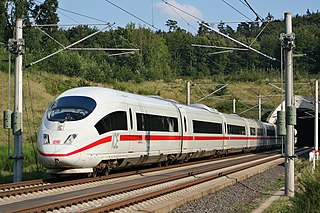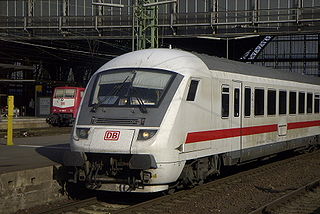
Intercity 2, abbreviated as IC2, refers to DB Intercity trains formed of double-deck rolling stock. Such trains were first introduced by Deutsche Bahn Fernverkehr in December 2015.

Intercity 2, abbreviated as IC2, refers to DB Intercity trains formed of double-deck rolling stock. Such trains were first introduced by Deutsche Bahn Fernverkehr in December 2015.
In order to be able to modernize old Intercity cars and to increase the vehicle reserve of the long-distance traffic, Bombardier Twindexx double-deck coaches are used in inter-city rail traffic with a maximum speed (Vmax) of 160 km/h. [1] The locomotive is a DBAG Class 146. [2] [3] [1]
These kinds of coaches are used in German Regional-Express trains, for Intercity services the coaches will get a more comfortable interior than in regional train double-decker coaches. In both classes only open coaches are provided, there will be no dining car. [4] The double-decker coaches have been in service since 2015. [5] Unlike most previous IC stock the new trains, marketed as "InterCity 2" by DB have a top speed of 160 km/h and are mainly intended for routes where higher speeds aren't possible or would offer little or no benefit with the ICE 4 to take over routes with maximum speeds between 160 km/h and 250 km/h. The IC2 is also intended to expand the Intercity network to cities that had lost their long-distance service upon withdrawal of the Interregio.

In 2020, 17 used Stadler KISS EMUs were purchased from WESTbahn. [6] These trains are able to operate at 200 km/h. 4-car units are denoted Class 4110, 6-car units are denoted Class 4010.
A first batch of 4-car units started operating on the Dresden-Berlin-Rostock line in March 2020. 6-car units started operating on the Stuttgart-Singen-Zurich line in December 2022. These latter units replaced the loco-hauled IC2 consists that had been intended to operate Stuttgart-Singen-Zurich. Loco-hauled IC2 units were only able to operate Stuttgart-Singen but could not continue on to Switzerland as the manufacturer had failed to achieve approval for the ETCS safety system that is required for Switzerland.

The Deutsche Bahn AG is the national railway company of Germany, and a state-owned enterprise under the control of the German government. Headquartered in the Bahntower in Berlin, it is a joint-stock company (AG) and the largest railway company in the world.

Intercity Express is a high-speed rail system in Germany. It also serves destinations in Austria, France, Belgium, Switzerland and the Netherlands as part of cross-border services. It is the flagship of the German state railway, Deutsche Bahn. ICE fares are fixed for station-to-station connections, on the grounds that the trains have a higher level of comfort. Travelling at speeds up to 320 km/h (200 mph), they are aimed at business travellers and long-distance commuters and marketed by Deutsche Bahn as an alternative to flights.

InterCity is the classification applied to certain long-distance passenger train services in Europe. Such trains generally call at major stations only.

DB Fernverkehr AG is a semi-independent division of Deutsche Bahn that operates long-distance passenger trains in Germany. It was founded in 1999 in the second stage of the privatisation of Deutsche Bahn, under the name of DB Reise&Touristik and was renamed in 2003.

The Rhine-Ruhr S-Bahn is a polycentric and electrically driven S-bahn network covering the Rhine-Ruhr Metropolitan Region in the German federated state of North Rhine-Westphalia. This includes most of the Ruhr, the Berg cities of Wuppertal and Solingen and parts of the Rhineland. The easternmost city within the S-Bahn Rhine-Ruhr network is Unna, the westernmost city served is Mönchengladbach.

The Bombardier Double-deck Coach is a bilevel passenger railcar currently manufactured by Alstom, which acquired Bombardier Transportation in 2021 used by various European railways and Israel Railways. The current generation of double-deck coaches can be run at speeds up to 200 km/h (125 mph). Depending on their configuration, each coach can seat 100 to 150 passengers.

City Night Line, abbreviated CNL, was a train category of German railway company Deutsche Bahn for overnight passenger train services between Germany and neighbouring European countries. In late 2015, Deutsche Bahn announced that it planned to terminate all night train services in December 2016, and this plan was implemented on 11 December 2016. The service on some CNL routes was replaced by ÖBB Nightjet services.

A control car, cab car, control trailer, or driving trailer is a non-powered rail vehicle from which a train can be operated. As dedicated vehicles or regular passenger cars, they have one or two driver compartments with all the controls and gauges required to remotely operate the locomotive, including exterior locomotive equipment such as horns, bells, ploughs, and lights. They also have communications and safety systems such as GSM-R or European Train Control System (ETCS). Control cars enable push-pull operation when located on the end of a train opposite its locomotive by allowing the train to reverse direction at a terminus without moving the locomotive or turning the train around.

The DB Class 403 was a series of three electric multiple units commissioned by the Deutsche Bundesbahn in the 1970s, an early predecessor of the Intercity-Express as a high-speed train. The units were mainly used for InterCity services and again by the Lufthansa airline in the 1980s. Due to the distinctive design of its front section, the unit was nicknamed the "Donald Duck". They were designed for operational speeds of up to 220 km/h, a speed which was also attained in extensive test drives, but they were limited to 200 km/h in regular DB service.

ICE 3, or Intercity-Express 3, is a family of high-speed electric multiple unit trains operated by Deutsche Bahn. It includes classes 403, 406,407 and 408, which are known as ICE 3, ICE 3M, New ICE 3 and ICE 3neo respectively. Three multisystem trains, known as ICE International, are owned by Nederlandse Spoorwegen. Based on the ICE 3M/F, Siemens developed its Siemens Velaro train family with versions used in Germany, Belgium, France, the United Kingdom, the Netherlands, Spain, China, Russia and Turkey. ICE 3 trains have a maximum speed of 320 km/h (200 mph) when travelling on the high-speed rail lines, however class 403 are permitted to go up to a maximum speed of 330 km/h (210 mph) when it travels on the high-speed route between Frankfurt and Cologne.

DBAG Class 411 and Class 415 are German tilting electric multiple-unit high-speed trains in service with DB Fernverkehr, commonly known as ICE T.

The DBAG Class 605, commonly known as the ICE TD is a high-speed diesel multiple unit (DMU) train, formerly in service with Deutsche Bahn and DSB.

The Stuttgart–Horb railway is a 67.227 kilometer-long railway in the southern part of the state of Baden-Württemberg in Germany, running from Stuttgart to Horb. It forms part of a railway known as the Gäubahn or Gäu Railway. The Royal Württemberg State Railways and the Baden State Railways constructed the majority of this line between the years 1866 and 1879. Today the partially single-track, fully electrified line features the high-speed Intercity-Express (ICE) service, with its tilting train technology, traveling from Stuttgart to Zürich. In addition, a multitude of local train services of numerous railway companies are on offer. The Gäu Railway is also a significant line in the North-South freight service system.

Intercity (IC) is the second-highest train classification in Germany, after the Intercity Express (ICE). Intercity services are locomotive-hauled express trains, usually over long-distances. There are Intercity routes throughout Germany and routes generally operate every other hour, with multiple routes giving a more frequent service on core routes. Intercity services are operated by the DB Fernverkehr division of Deutsche Bahn, Germany’s national railway.

ICE 4 is a brand name for long-distance Intercity-Express high-speed trains being procured for Deutsche Bahn.

S-Bahn Mitteldeutschland represents an enlargement of the previous Leipzig-Halle S-Bahn. It is an electric rail public transit system operating in the metropolitan area of Leipzig-Halle, Germany. This S-Bahn network developed from two separate S-Bahn networks of Halle (Saale) and Leipzig, which were established separately in 1969 and then linked in 2004. With the opening of the Leipzig City Tunnel on 15 December 2013 as a new artery, the network was extended for the first time to the federal states of Thuringia and Brandenburg. With a system length of 802 km (498 mi), it is the largest S-Bahn network in Germany, displacing the long-time title holder Rhine-Ruhr S-Bahn from that position. The locomotive-hauled double-decker trains partly dating back to the DDR-era have been largely replaced by electric multiple unit Bombardier Talent 2 trains, but some are still used during rush hour.
Mozart was an express train that linked Paris with Vienna via Strasbourg, Stuttgart and Munich. The service began in 1954, as an F-Zug named Mozart Express running between Strasbourg and Salzburg, before being extended ten years later. In 1983 it was re-classified as an FD-Zug and it was added to the EuroCity network in 1989. It operated until 2007, when it was replaced by a TGV service on the newly opened LGV Est. It was named after the composer Wolfgang Amadeus Mozart, and served many cities with which he had an association.

Naumburg (Saale) Hauptbahnhof is located in the German state of Saxony-Anhalt and is classified by Deutsche Bahn as a category 3 station. The station is part of the zone of the Mitteldeutscher Verkehrsverbund and is the main station of the Burgenlandkreis (district).

Singen (Hohentwiel) station is an important regional railway junction and interchange station in the town of Singen in the south of the German state of Baden-Württemberg. Three railways now meet there, but in the past five railways connected to it. The station is served by InterCity trains on the Stuttgart–Zurich route.

ICE L is a long-distance locomotive-hauled push-pull train which is being built by the Spanish company Talgo for the German train operator DB Fernverkehr and is scheduled to commence operation from 2024. The name of the train was changed in 2021 from its previous working title ECx, with the L standing for low-floor entry. The trains form part of the manufacturer's Talgo 230 family of trains. The Talgo Travca locomotives ordered for the service are designated DB Class 105. They will replace old Intercity (IC) trains in Germany.
{{cite web}}: CS1 maint: multiple names: authors list (link){{cite web}}: CS1 maint: multiple names: authors list (link)